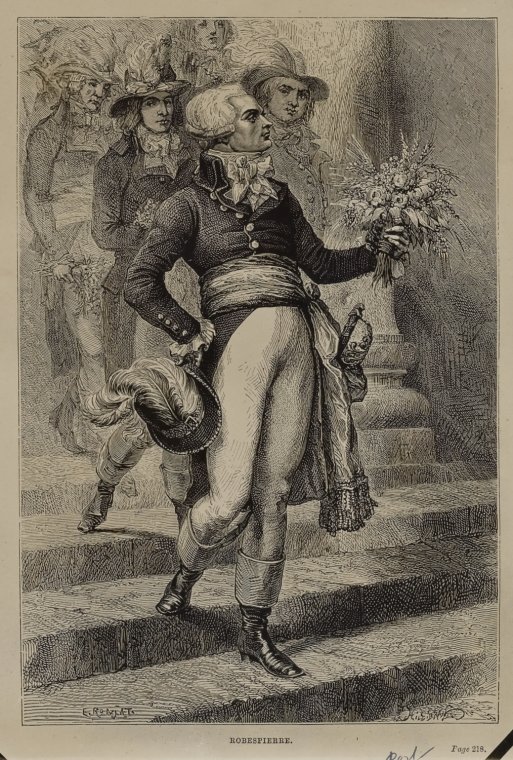By the time her Memoirs were written in 1838, Madame Tussaud was well advanced in modelling her own legend - Revolutionary history repackaged into tempting tableaux for a Victorian audience, with our heroine centre-stage. Who is to know whether she even met Maximilien? Nonetheless her Robespierre is interesting and possibly quite close to the man himself - reserved, careful of his appearance, thoughtful and courteous, not at all the stereotypical caricature of the bloodthirsty Terroriste.
Madame Tussaud recalls a visit to the newly-stormed Bastille in 1789
 |
| Robespierre in crowd-pleasing mode Festival of the Supreme being 19c. lithograph, New York Public Library |
In this first scene Robespierre appears as a super tour
guide, declaiming against the "caprice of royalty" among the dungeons
and abandoned torture instruments of the soon-to be-demolished Bastille. When Marie stumbles, Max gallantly steps in to save her:
Amongst others who were induced to visit those melancholy mementos of despotism and tyranny, Madame Tussaud was prevailed upon to accompany her uncle and a few friends for that purpose; and whilst descending the narrow stairs, her foot slipped, and she was on the point of falling, when she was saved by Robespierre, who, catching hold of her, just prevented her from coming to the ground; in the language of compliment observing, that it would have been a great pity that so young and pretty a patriot should have broken her neck in such a horrid place. How little did Madame Tussaud then think, that she should, in a few years after, have his severed head in her lap, in order to take a cast from it after his execution (p.372).
Marie has dinner with Robespierre
At the height of the Terror Robespierre takes time out from making history to dine regularly with Madame Tussaud's adoptive uncle and mentor, Curtius:
 |
| Robespierre appears as a neat and sensitive young man in this drawing from the collections of the Château de Versailles |
There was not any thing particularly remarkable in Robespierre's conduct, manners, or appearance, when in society ; if noticed at all, it could only be as a pleasant, gentlemanly man, of moderate abilities......(pp.384-5)
Robespierre the ladies' man
 |
| Well turned-out in happier times... Portrait by Louis Léopold Boilly. Palais des Beaux-Arts de Lille |
Robespierre, Madame Tussaud states, was a middle-sized man, marked with the small-pox, and wore green spectacles, for the purpose of hiding, perhaps, his eyes, which were particularly ugly, the white being of a yellow cast; it has been also stated, that his sight was weak ; his features were small, inclining to sharpness ; they were not particularly expressive of ferocity, nor had they any thing sufficiently remarkable to have attracted notice, had he not rendered himself conspicuous by his enormities.
In one respect he formed a perfect contrast to Marat, being fond of dress. He usually wore silk clothes and stockings, with buckles in his shoes; his hair powdered, with a short tail ; was remarkably clean in his person, very fond of looking in the glass, and arranging his neckcloth and frill. Robespierre exhibited much gallantry towards the ladies, and perhaps the reader may think sometimes carried his politeness too far. Walking one day on the Boulevards with a lady, she admired a house, which much struck her fancy. " Would you like to have it?" demanded Robespierre. " Indeed I should," replied the lady. " Then, madam, it shall be yours," said Robespierre ; and absolutely carried his courtesy so far as to have the owner denounced as an enemy to the republic, and immediately executed, and his property confiscated ; by which means Robespierre easily obtained possession of the house, and presented it to the lady. There is no politeness equal to that of the French, after all.
Reference
Memoirs of Madame Tussaud by Francis Hervé.
in Adam Waldie's The Select Circulating Library, Volume 13, Part 1 (1839)
https://play.google.com/store/books/details?id=7rQ-AAAAYAAJ&rdid=book-7rQ-AAAAYAAJ&rdot=1

No comments:
Post a Comment